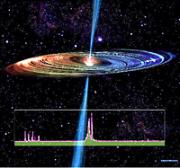Extragalactic Distance Scale
Supermassive black holes are now thought to lie at the centers of many if not all galaxies. Under the right conditions, X-ray emission from hot gas very close to the black holes can stimulate water molecules further out to emit maser (i.e., microwave laser-like) emission. The emission lines from these maser regions are so sharp and strong, and the angles measurable by very long baseline interferometry so exquisitely small (milliarcseconds) that it is possible to measure maser orbital velocities to within a fraction of a parsec of the black hole, just a few tens of thousands of Schwardschild radii. Further, these masers are orbiting so rapidly (~1000 km/s) that after a few years it is possible to measure quite readily orbital accelerations. These measurements can be used to obtain very direct "geometric" distances for their host galaxies, free of the specific systematic and calibration errors that occur in the conventional "distance ladder" methods for determining extragalactic distances (e.g., measurement of Cepheid light curves). Combination of maser and traditional techniques has provided the best estimate of the distance scale to date.
About 20 years ago, RG astronomers used the Very Long Baseline Array of the NRAO to obtain the first extragalactic distance using this technique, for the galaxy NGC 4258 (see figure and caption). This effort led to discovery of arguably the first direct evidence for a supermassive black hole in any galactic nucleus (including our own), as well as the most accurate single extragalactic distance. Today, the distance uncertainty for NGC4258 is just 3%.
In the last decade, the number of known masers has more than trebled, and there are now another ten or so whose study may result in distance measurements accurate to about 10%. The combination of many such measurements will further measurement of the distance scale. RG astronomers led early surveys of Active Galactic Nuclei (AGN) in a search for new masers, e.g., the Smithsonian All-sky Megamaser and Blackhole Survey (SAMBA). Work continues via collaboration in the northern hemisphere Megamaser Cosmology Project of the NRAO and via leading the new southern hemisphere Tidbinbilla AGN Maser Survey (TAMS). Long term goals include increasing the number of candidates suitable for distance measurement and achieving an uncertainty on the expansion rate of the universe (the Hubble constant) of 1-2%.
Alice Argon, Lincoln Greenhill, Jim Moran, Mark Reid
External Collaborators: Tom Kuiper, Ingyin Zaw




